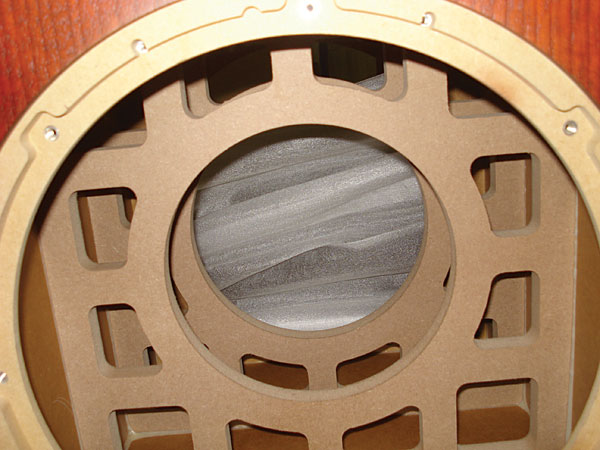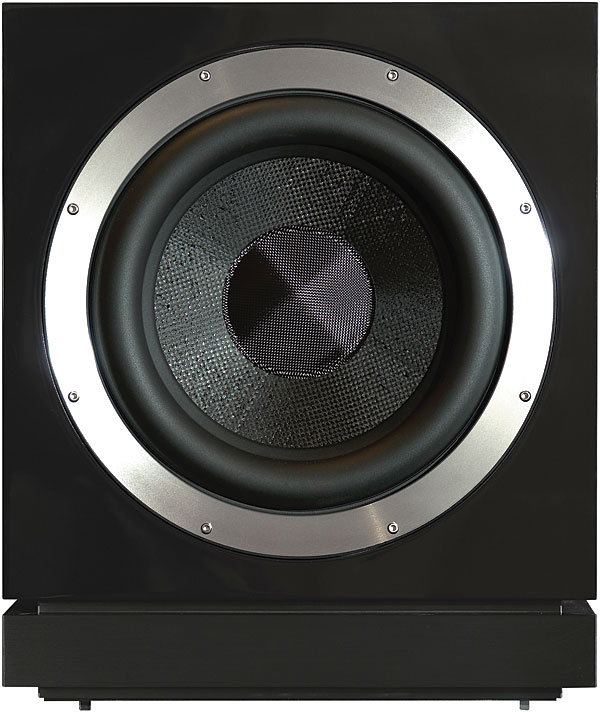| Columns Retired Columns & Blogs |
9th paragraph
The DB1's internal electronics include a signal input circuit board that concrets the analog input ( concrets ?, includes ? perhaps)
Setup
I unpacked the DB1 and moved it into the right corner of my living room, behind one of my Quad ESL-989 speakers, positioned so its control panel and display faced out into the room, and each of its two drivers faced one sidewall. The Quads sat 8' apart, 5' from the front wall and 3' from the sidewalls, slightly toed-in to my listening chair and driven by a Mark Levinson No.334 dual-mono solid-state amplifier. My chair was 10' from each Quad. The DB1 was connected to the outputs of my Bryston BP-26 preamplifier via two 6m, unbalanced, line-level interconnects.

The B&W DB1 has one of the easiest and quickest setup routines I've encountered with a subwoofer of this sophistication. Setup took less than 10 minutes, whether by ear or by gear. (See Sidebar, "B&W Room Acoustics Compensation").
Sound
Keeping true to Darren Gum's request in the sidebar, I evaluated the sound of the DB1 without the help of the Bryston 10B-SUB's high-pass filter to restrict demands on the Quads to play very low bass. This helped maintain the Quads' upper-midrange and treble transparency, but caused their protection circuits to kick in during loud bass peaks. For example, both Quads shut off at the beginning of Mark Flynn's kick-drum introduction to "Blizzard Limbs," from Attention Screen's Live at Merkin Hall( (CD, Stereophile STPH018-2). However, I liked the Quads' unfiltered, full-range sound so much that I dialed back the preamplifier's volume to avoid triggering further shutdowns.
From the start, I enjoyed the DB1's ability to move air, its superb pitch definition, and its ability to integrate its own deep bass with the Quads' midbass. I was most impressed with the DB1's power while producing clean, tuneful low frequencies. The fortissimo( bass-drum strokes in the second movement of Stravinsky's The Rite of Spring, with Esa-Pekka Salonen conducting the Los Angeles Philharmonic (SACD/CD, Deutsche Grammophon 00289 477 6198-2), seemed to jump out into the room with tremendous speed and impact. I heard the same punch from the bass percussion in another performance of Rite, by the Minnesota Orchestra under Eiji Oue (HDx DVD-R, 24-bit/176kHz, Reference RR-70). The DB1 captured the distorted, menacing bass synth that opens "Deeper Wells," from Emmylou Harris's Spyboy (Eminent EM-25001-2), as well as the stark impacts of the explosive timpani strokes in Yoshihisa Taira's Hierophonie V, performed by the Kroumata Percussion Ensemble (CD, BIS BIS-232).
The DB1's tuneful bass power allowed it to not only reproduce the bass notes of pipe organs, but also to reliably create room lock: when an organ note massively vibrates the air in my listening room without boom. This clean depiction of deep bass power was apparent at even lower volumes, such as the soft but stunning deep pedal note that ends the excerpt from John Atkinson's recording of Elgar's The Dream of Gerontius on Stereophile's Test CD 2 (CD, Stereophile STPH004). The massive, almost infrasonic organ note that ends Timothy Seelig and the Turtle Creek Chorale's performance of "Lord, Make Me an Instrument of Thy Peace," from John Rutter's Requiem (CD, Reference RR-57CD), was stunning in its power and beauty. The DB1 helped the Quads create a deep, broad soundstage on which deep pedal notes, full choir, and harp surged out from Rutter's A Gaelic Prayer, on the same disc, and delivered the rumbling pulses that underpin Gnomus, from Jean Guillou's performance of his transcription of Mussorgsky's Pictures at an Exhibition (CD, Dorian DOR-90117). Mary Preston's raucous interpretation of the Toccata of Widor's Organ Symphony 5, on Organ Odyssey (CD, Reference RR-113CD), was equally dramatic with the DB1.

The DB1 also revealed the characteristic bass timbres of other instruments, such as: the taut, dense energy of Michael Arnopol's double-bass in the introduction to "Too Rich for My Blood," from Patricia Barber's Café Blue (CD, Premonition/Blue Note 5 21810 2); the harsh shudder of David Hudson's bass didgeridoo, which drives "Rainforest Wonder" on his Didgeridoo Spirit (CD, Indigenous Australia IA2003 D); the distinct tonal steps of Glen Moore's plucked double-bass notes in "The Silence of a Candle," from Oregon's Beyond Words (CD, Chesky JD130); the delicate bass-guitar line that Jerome Harris threads among the other instruments in "The Mooche," from the Jerome Harris Quintet's Rendezvous (CD, Stereophile SPTH013-2); the double-basses playing the sustained low G in the introduction to Richard Strauss's Also sprach Zarathustra, from Erich Kunzel and the Cincinnati Pops' Time Warp (CD, Telarc CD-80106); and the fabric-covered mallet used on the bass drum in H. Owen Reed's La Fiesta Mexicana, from Fiesta! (CD, Reference RR-38CD).
Comparisons
Listening also to the Velodyne DD-18 ($4999) and JL Audio Fathom f113 ($3600) subwoofers allowed me to better grasp the characteristics of the B&W DB1 ($4500). The similarly priced DD-18 has a high-pass filter and a larger driver (18"), and uses servo correction; its audible bass power seemed on a par with the DB1's. The DB1 and Velodyne produced the most room lock. The less-expensive JLA Fathom f113 had slightly better pitch definition. I heard a deeper, wider soundstage when I had two f113 subwoofers playing in stereo, compared with the single DB1, but I didn't have two identical pairs of DB1s or Velodynes to determine if either could do as well. Even with these differences, however, I could easily live with any of these subwoofers.
Conclusions
The B&W DB1 proved to be a real pocket rocket, producing from a relatively small enclosure taut, powerful deep bass with outstanding pitch definition. Add to that its fine cabinetry and the ease and convenience of running B&W's Room Acoustics Compensation software and setup adjustments from my listening chair, and the DB1 really excelled.
As a two-channel guy, I would have preferred that B&W included a switchable high-pass filter for managing the bass, so that I could obtain that extra bit of dynamic range from my Quads without clipping, but the combination of DB1 and ESL-989s sounded so good that it more than offset my frustration with having to keep the volume lower. However, DB1's ability to blend sonically with my Quad electrostatics, more than justifies its high asking price. And the ability to fine-tune its performance from the listening chair is a truly innovative step in making subwoofer setup easier, more feasible, and ultimately more reliable. These strengths put the DB1 on my short list of recommended subwoofers.

I have been "messing about" with subwoofers since 1977 when I got a 12" "acoustic suspension" subwoofer to augment the bass on my Magnepan MG-IIs. This was a passive sub whose adjustability consisted in using various resistors to adjust its level relative to the main speaker. While it added need punch for rock records, it did nothing for the quality of the sound and I never used it when listening to classical music.
In 1979 I sold the entire rig because I didn't have a room big enough to accommodate all of that stuff.
15 years later, I got a Mirage BPS-150 powered sub with the usual crossover and level controls. I never successfully mated it with the first pair of speakers I tried (Snell K-IIs), but after much trial and error got it to sound acceptable with Joseph RM-7sis. At that point someone one of the Audio Asylum boards mentioned the inexpensive Behringer parametric equalizers, which can be used with a calibration mic. I managed to get one used, even cheaper. Finally, really good bass that did not boom, although the Mirage really didn't do much below 30 Hz. Replacing the Mirage with a REL Q400E got me a little more extension with much better definition.
Here's my point: the chances of a serious audiophile making a net improvement in sound adding in a subwoofer "by ear" are, I believe, very small; and the chances of worsening the sound are not insignificant. So, the audiophile who can't afford a self-calibrating sub like the one you reviewed should, I think, either by a unit like the Bheringer or save his/her money.